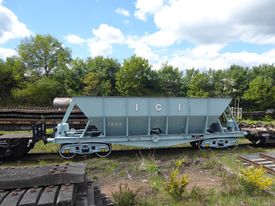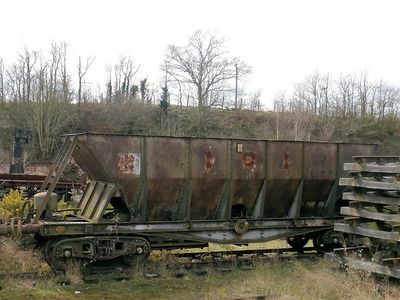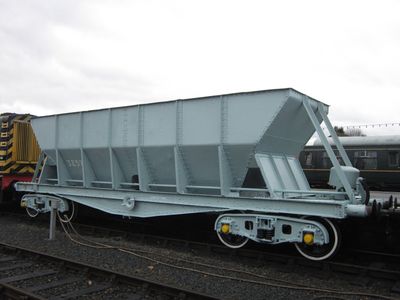ICI 19052 Bogie Steel Hopper Wagon
| ICI 19052 Bogie Steel Hopper Wagon | |
|---|---|
 ICI Bogie Steel Hopper Wagon 19052 carrying number 3252 at the Stourport Triangle, May 2021. | |
| Built By | Chas. Roberts, Wakefield |
| Status | Cosmetically restored |
| Number | 3252 |
| Other Numbers | ICIM 19052, LMSR 151397 (reg) |
| History | |
| Built | 1938 |
| Diagram | 6/486 |
| Type | Bogie steel hopper |
| Capacity | 48 tons |
| TOPS code | PHV, JGV after 1990 |
| Brakes | Vacuum fitted |
| 1994 | Arrived on the SVR |
| 2020 | Cosmetically restored |
Contents
Construction
The wagon is of all steel construction. It is mounted on diamond frame pattern bogies of 6 ft. wheel-base, 26 ft. between centres, and is equipped with automatic vacuum brakes in addition to hand-brakes on either side, the power cylinders being fixed at each end of the frame and applying four blocks to each bogie.[1]
The hopper is 29 ft 6 in long by 7 ft 11 in wide at the top, decreasing to 18 ft 3 in by 2 ft 1½ in at the bottom, with a depth of 7 ft 11 in. This gives has a capacity of 1,230 cubic feet, equating to a load variously quoted as between 43½ tons and 48 tons.[note 1] The load is discharged between the rails through two bottom doors, each having a clear opening of 7 ft 7½ in by 2 ft 1½ in. These doors are fitted with a patent opening and closing device, the load inside forcing them open when they are released and at the same time compressing the springs that control them. On reaching their full-open position the doors are held in a catch until the load is discharged; on being released the energy stored in the springs forces them back into the closed position. The whole operation of releasing, discharging, and reclosing was said to take less than two minutes[1].
Service
The entry to service of Stanier 8F locomotives in 1935 led to a major change in the heavy limestone traffic between the quarries at Tunstead, near Buxton in the Derbyshire Peak District, and the I.C.I. processing works at Northwich. The 8F's tractive power made it possible to introduce large vacuum-braked bogie hopper wagons designed specifically for this traffic. For something like thirty years the 8F's remained closely associated with this service; other motive power included Super D's and Derby 4's although class 9F locomotives were never used on these runs before diesel traction replaced the 8Fs. After steam ended, the rakes of the wagons remained in regular use on limestone traffic, initially hauled by Class 25 type 2s and latterly by Class 37 type 3s.[1]
During service this wagon was given BR TOPS no. 19052 and LMS registration no. 151397.[1]. The TOPS code for this class of wagon was originally PHV, recoded to JGV in 1990[2].
Preservation
Although there is no record that 48773 was used to haul ICI mineral traffic, owning group the Stanier 8F Locomotive Society decided in 1993 to preserve one or more of the wagons in view of their close association with the 8F class, none having been saved for preservation at that time.[1]
Negotiations with the SVR secured the agreement for the Railway to accept two wagons if the 8F Society could obtain and transport them, and subject to inspection of their running capability and general condition. The two selected wagons were purchased from Buxton Lime Industries Ltd. on 8 November 1993. Delivery of both wagons was scheduled to allow them to make an early appearance in a photographic freight charter on 3 May 1994 but an extended commitment of three Alleleys' low loaders prevented this. Delivery was re-scheduled for 7 May; in the event 19129 arrived on the day but 19052 was delayed by various technical and administrative problems and finally arrived at Kidderminster on 16 May.[1]
The 8F Society had chartered two inspection saloon specials for their AGM on 18 June 1994. Having failed to make the earlier freight charter, they had hoped to attach the wagons so they could be displayed in use. However it transpired that to do this, the hoppers would need to be accompanied by a brake van, requiring repetitive shunting during the day which could not be accommodated. By that time, one hopper was at Kidderminster, largely concealed behind visiting diesels and other stock in the yard, and the second was at Highley.[1]
After arrival both wagons remained in "as received" condition for many years, latterly stored on the Stourport Triangle.
The Society's Board planned to restore the older wagon, 19052, in the experimental livery of 1936/37. Smaller lettering for 'I.C.I.' was used on pre-war hoppers; a very much smaller 'Ltd.' was not added after late 1937.[1] Cosmetic restoration finally took place during 2020.
The Board also decided that the later wagon (BR TOPS no. 19129, no 3329 built in 1952) was to be restored in I.C.I's. post-War colour specification at overhaul, all grey with black wheelsets and white lettering.[1] However this still remains an ambition as of 2023[update].
See also
Notes
- ↑ The SVR Stock Book and Stanier 8F Society give the load capacity as 43½ tons. Marsden (1984) p. 89. and the Railway Heritage Register Wagon survey both give 48 tons.

